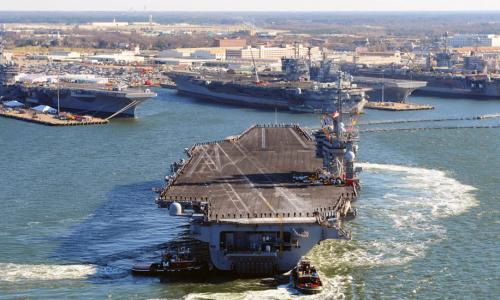Naval Station Norfolk within the Hampton Roads metropolitan area—a sea level rise hot spot, where natural subsidence, low-lying topography, and changing ocean circulation patterns contribute to above-average sea level rise.
In the area around Norfolk, seas are projected to rise between 4.5 and 6.9 feet by the end of this century. Much of the station lies less than 10 feet above sea level.
During the second half of the century, in the absence of preventive measures, NS Norfolk can expect more frequent and extensive tidal flooding, loss of currently utilized land, and substantial increases in the extent and severity of storm-driven flooding.
Base information
This location is one of 18 military installations featured in the 2016 report, "The US Military on the Front Lines of Rising Seas."NS Norfolk is the largest naval installation in the world and the home of the US Fleet Forces Command, which trains naval forces and defends a massive area including the Atlantic Ocean and parts of the Pacific.
More than 22,000 military personnel live in the city of Norfolk, making up 11 percent of the population. The city is also home to 28,000 veterans.
NS Norfolk lies directly on the water, with the Elizabeth River to the west and Willoughby Bay to the north.
Projected exposure to coastal flooding
The base's exposure to coastal flooding is projected for the years 2050, 2070, and 2100 based on the National Climate Assessment’s midrange or “intermediate-high” sea level rise scenario (referred to here as “intermediate”) and a “highest” scenario based on a more rapid rate of increase.
Tidal flooding, land loss, and storm surge from hurricanes were all modeled. In this analysis, land inundated by at least one high tide each day is considered a loss. This is a conservative metric: in reality, far less frequent flooding would likely lead to land being considered unusable.
The results below outline potential future flooding scenarios for NS Norfolk, assuming no new measures are taken to prevent or reduce flooding.
- Certain locations could flood with each high tide. Today, tidal flooding in the Norfolk area affects low-lying areas nine times per year on average. But in the intermediate scenario, such areas in and around the station flood about 280 times per year and spend 10 percent of the year underwater by 2050.
- The reach of flooding during extreme high tides will expand. In the intermediate scenario, extra-high tides would expose roughly 10 percent of the station’s land
area to flooding by 2100; in the highest scenario, exposure reaches nearly 60 percent. - Land loss at NS Norfolk is possible. In the highest scenario, roughly 20 percent of NS Norfolk’s land floods daily, becoming part of the tidal zone, by 2100.
- Sea level rise exposes previously unaffected areas of NS Norfolk to storm surge flooding. In the intermediate scenario, the area exposed to flooding resulting from a Category 1 storm more than triples by 2070.
- Higher sea levels allow lower-intensity storms to produce greater surge. In the intermediate scenario, storm surge flooding resulting from a Category 1 storm hitting in 2100 affects a greater area than does surge flooding resulting from Category 2 storms today.
- Sea level rise exposes NS Norfolk to deeper, more severe flooding. Today, a Category 4 storm exposes about 80 percent of the station to flooding, and that flooding is less than 10 feet deep. In the highest scenario, a Category 4 storm hitting in 2100 exposes 95 percent of the base to flooding more than 10 feet deep.
Preparing for rising seas
Recognizing the threat in the vital Hampton Roads region, the Navy is working to develop solutions to the adverse effects that can be expected with sea level rise, including incorporating sea level rise projections into its development and infrastructure planning.
NS Norfolk has also been raising some of its piers—at a cost of $60 million each—and restoring others. The station is planning a $250 million restoration project that includes demolishing two of its 100-year-old piers and rebuilding one new pier at NS Norfolk. And the Department of Defense, along with other federal agencies and local stakeholders (Hampton Roads lanning District Commission, Norfolk, and Virginia Beach), is participating in an innovative study in Hampton Roads to address recurrent flooding and sea level rise.
But there is still far to go: The gap between the military’s current preparedness for sea level rise and the threats outlined here is large and growing.
In order to plan effectively for the long term, military decision makers with authority over NS Norfolk need to understand how sea level rise may permanently alter the landscape of this coastal installation and where the threat of storm surge may become intolerable.
To take action, however, individual installations like NS Norfolk will need more detailed analysis and resources to implement solutions.
Congress and the Department of Defense should, for example, support the development and distribution of high-resolution hurricane and coastal flooding models; adequately fund data monitoring systems such as our nation’s tide gauge network; allocate human, financial, and data resources to detailed mapping and planning efforts at military installations; and, as adaptive measures are identified, allocate resources for these projects, many of which will stretch over decades.
Our defense leadership has a special responsibility to protect the sites that hundreds of thousands of Americans depend on for their livelihoods and millions depend on for national security.
Additional maps and resources
This analysis modeled exposure to coastal flooding for four different points in time (2012, 2050, 2070, and 2100) and two different sea level rise scenarios.
For each time horizon and scenario, we analyzed storm surge from Category 1 through 5 hurricanes, the extent and frequency of flooding from extra-high tides, and inundation from ordinary high tides.
Detailed maps for each scenario at NS Norfolk are available via Dropbox.
For more, please see the methodology used for this analysis.




